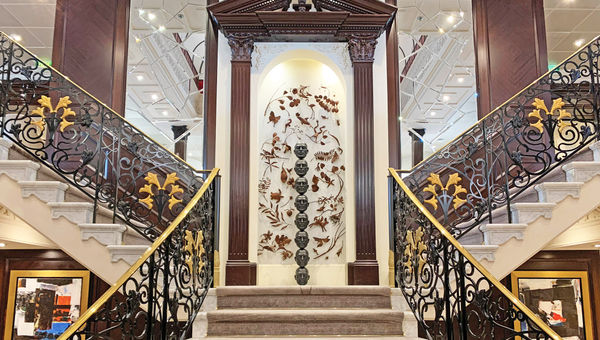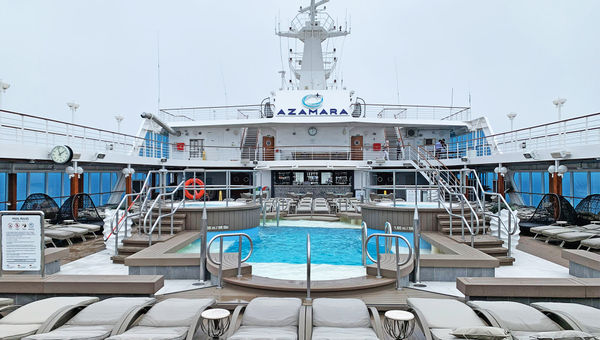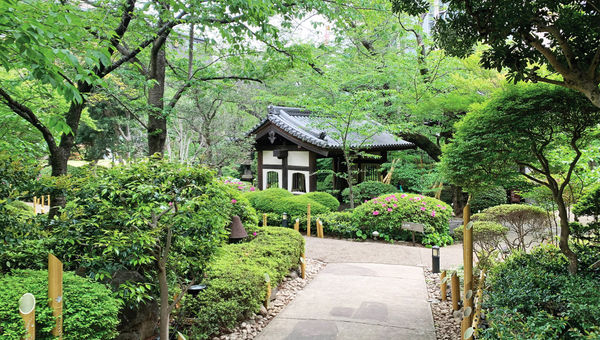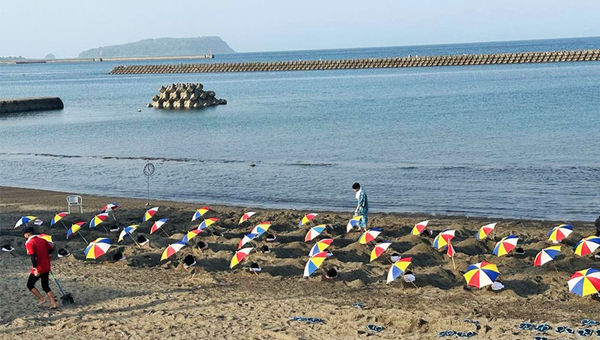Just one quick nasal swab at the terminal, and it was over. That was the extent of the Covid-related procedures that guests had to endure before boarding the Azamara Quest in Tokyo.
I boarded the ship for its final week sailing in Japan before it headed farther south, visiting Taiwan, Hong Kong, Vietnam and finally, Singapore.
The ship spent nearly seven weeks in Japan starting in March and sailing through the height of cherry blossom season before continuing southward with a full load of passengers.
Azamara is one of several cruise lines that returned to Japan after the country reopened to tourism last fall. The ships sailing here have some Covid-related protocols in place, such as the pre-embarkation test required by Japan, which has so far allowed for a smooth return to cruising.

The Quest’s foyer area. Photo Credit: Ramsey Qubein
Surging demand
As one of the last regions in the world to reopen its borders, Japan and the rest of Asia are seeing a quick ramp-up of travel demand. My sailing in March did not have a single empty cabin.
Azamara representatives say that, typically, Asia sailings book up between three and four months before departure. This year, however, cabins were snapped up far sooner because of the intense demand for traveling in the region.
Japan's tourism ministry reports that international cruise ships visited Japanese ports nearly 1,900 times in 2019, representing almost $600 million in economic impact. This year, the number is expected to be about 1,200 port visits.

The pool deck on the Azamara Quest. Photo Credit: Ramsey Qubein
Bucket-list trip
Many of the passengers on the Quest sailing said this had been a bucket-list trip for them. Some had finally managed to rebook itineraries that were canceled during the pandemic, while others were keen on exploring some of the lesser-known ports that only small-ship cruise lines like Azamara can call in.
Some guests said that until last year they had not considered a cruise in Japan. But they found it to be the most convenient way to get around the country, one that meant no need to navigate language barriers alone and an ideal way to visit many destinations on one trip.
The Quest drew a mostly American crowd on this sailing, although a smattering of other nationalities were aboard, including guests from the U.K. and Australia (two of the company's top markets).
Fellow passengers had traveled extensively, many devout Azamara loyalists, and were eager to visit Asian ports of call now that they are no longer off-limits.
Surprisingly, I recognized several people from past Azamara cruises, including some of the company's top cruisers who had sailed at least 700 nights with the brand. It was clear this itinerary was attracting a diverse group.

The ship’s Discoveries dining room. Photo Credit: Ramsey Qubein
Warm welcome
This was my first visit to Japan since the pandemic, and I was surprised to find things had mostly returned to normal. Aside from mask-wearing, still common in this part of the world, and sanitization stations everywhere, restrictions were mostly gone.
After departing Tokyo, the Quest headed south to Osaka, but it also stopped in smaller ports like Kochi and Kagoshima, two cities in the southern part of the country. Activities included a traditional bonito roast over roaring flames, a visit to the active Sakurajima volcano, onsen baths and bullet-train excursions to Kyoto or Kobe.
Most notable was that in these secondary ports, the arrival of a cruise ship becomes an event, drawing community members to see the ship and interact with guests. In Kagoshima, locals were in the terminal making complimentary origami ornaments and decorations for passengers to take, a generous gift that made a great souvenir. And in both Kagoshima and Kochi, bands and school groups performed as hundreds of locals waved goodbye shouting "Thank you for visiting" and "Have a good trip" as the ship sailed away. It was a touching and poignant reminder of how cruises can impact the local economy and connect people and cultures from around the world.
Azamara has been busy making onboard improvements, too, including a new WiFi system that is faster than previous versions. Also new is an impressive vegetarian and vegan menu at the Quest's two specialty restaurants, Mediterranean-focused Aqualina and the Prime C steakhouse. Azamara's executive chef is vegan and wanted to expand the offerings onboard for the growing number of people requesting it. Vegan options are now available nightly in the main Discoveries dining room and closely mirror the other themed flavors of the evening's menu.

The gardens surrounding the Grand Prince Hotel Takanawa in the Minato section of Tokyo. Photo Credit: Ramsey Qubein
Extended port stays
The cruise experience and shore excursions are largely back to normal. There are no onboard restrictions for passengers, although crew members continue to wear masks when indoors. Shore excursions have shed any pandemic-related limitations, and travelers will find the experience to be what they remembered.
Aside from the negative Covid test required to board, things are back to normal. Azamara favorites are back in full force. The ship spent more time in ports, sometimes overnight, giving guests the chance to explore farther than they would be able to on a typical 8 a.m. to 5 p.m. port visit.
A late-night departure from Osaka, for example, gave passengers the chance to independently visit neighboring cities by train if they wanted.
An overnight stay in Kagoshima encouraged passengers to stay the night in a ryokan. They could also visit the beach town of Ibusuki, on the very southern tip of Japan, and indulge in the local tradition of hot sand bathing. People don yukata robes and are buried up to the neck in the thermal, volcanic sand on the beach as they take in the view of the crashing waves in the distance. The natural experience is supposedly good for both the skin and the immune system.

Ibusuki Beach, south of Kagoshima, where visitors enjoy being buried up to the neck in hot sand. Photo Credit: Michelle Blaugrund
AzAmazing is back and being expanded
For a brief period during the pandemic, Azamara paused its AzAmazing evenings, the complimentary activity on every Azamara sailing that takes guests to a special location unique to a destination, and held the events onboard.
They are back in full swing, and Hong Kong was the port chosen for the AzAmazing evening of this Tokyo-Singapore itinerary. And now, after 10 years, Azamara will expand the program by doubling down on the concept, holding more of the activities during each sailing and introducing daytime version of the events as well.
AzAmazing Days will connect guests with local food, musicians and entertainers on shore for the daytime experience. They will begin this summer, with the first one held in the picturesque village of Portovenere, Italy, where Azamara Onward guests can stroll through the town and enjoy a buffet with local chefs and musicians for entertainment.
In addition, Azamara has begun adding Destination Celebrations activities that bring more local touches onboard, including cultural performances and local cuisine.